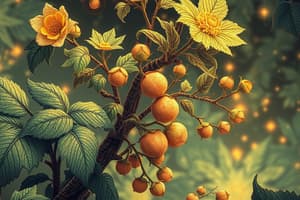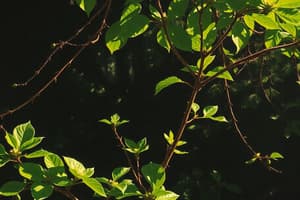Podcast
Questions and Answers
Welke soort organisme gebruikt lichtenergie om voedsel te produceren?
Welke soort organisme gebruikt lichtenergie om voedsel te produceren?
- Saprotoof
- Heterotroof
- Autotroof (correct)
- Mixotroof
Welke vorm van nutrition gebruikt chemische energie uit anorganische verbindingen om voedsel te produceren?
Welke vorm van nutrition gebruikt chemische energie uit anorganische verbindingen om voedsel te produceren?
- Chemosynthese (correct)
- Holozoïsch nutrition
- Saprotrofie
- Phototrofie
Wat is het resultaat van autotrofische nutrition?
Wat is het resultaat van autotrofische nutrition?
- Eiwit en vetzuren
- Koolstofdioxide en water
- Gluucose en zuurstof (correct)
- Koolhydraten en aminozuren
Welke soort organisme is afhankelijk van andere organismen voor voedsel?
Welke soort organisme is afhankelijk van andere organismen voor voedsel?
Welke vorm van heterotrofische nutrition absorbeert opgeloste organische stoffen?
Welke vorm van heterotrofische nutrition absorbeert opgeloste organische stoffen?
Welke vorm van nutrition combineert autotrofische en heterotrofische modi?
Welke vorm van nutrition combineert autotrofische en heterotrofische modi?
Flashcards are hidden until you start studying
Study Notes
Autotrophic Nutrition
- Autotrophic organisms are capable of producing their own food using light energy from the sun or chemical energy from inorganic compounds.
- Autotrophs use carbon dioxide as their carbon source and release oxygen as a byproduct.
- Types of autotrophic nutrition:
- Phototrophy: uses light energy to convert carbon dioxide and water into glucose and oxygen (e.g., plants, algae, cyanobacteria).
- Chemosynthesis: uses chemical energy from inorganic compounds to convert carbon dioxide and water into glucose and oxygen (e.g., some bacteria).
Heterotrophic Nutrition
- Heterotrophic organisms are unable to produce their own food and rely on consuming other organisms or organic matter for energy and nutrients.
- Heterotrophs use organic compounds as their carbon source and release carbon dioxide as a byproduct.
- Types of heterotrophic nutrition:
- Holozoic nutrition: ingests solid organic matter (e.g., animals, fungi).
- Saprotrophic nutrition: absorbs dissolved organic matter (e.g., some bacteria, fungi).
- Parasitic nutrition: obtains nutrients from a living host (e.g., parasites, some fungi).
- Mixotrophic nutrition: combines autotrophic and heterotrophic modes of nutrition (e.g., some protists).
Autotrofe Voeding
- Autotrofe organismen kunnen hun eigen voedsel produceren met behulp van lichtenergie uit de zon of chemische energie uit anorganische verbindingen.
- Autotrofen gebruiken koolstofdioxide als koolstofbron en laten zuurstof vrij als bijproduct.
- Er zijn twee soorten autotrofe voeding:
- Fototrofie: gebruikt lichtenergie om koolstofdioxide en water om te zetten in glucose en zuurstof (bv. planten, algen, cyaanbacteriën).
- Chemosynthese: gebruikt chemische energie uit anorganische verbindingen om koolstofdioxide en water om te zetten in glucose en zuurstof (bv. sommige bacteriën).
Heterotrofe Voeding
- Heterotrofe organismen kunnen geen eigen voedsel produceren en zijn afhankelijk van het consumeren van andere organismen of organische stof voor energie en voedingsstoffen.
- Heterotrofen gebruiken organische verbindingen als koolstofbron en laten koolstofdioxide vrij als bijproduct.
- Er zijn vier soorten heterotrofe voeding:
- Holozoïsche voeding: neemt vaste organische stof op (bv. dieren, schimmels).
- Saprotrofe voeding: neemt opgeloste organische stof op (bv. sommige bacteriën, schimmels).
- Parasitaire voeding: haalt voedingsstoffen uit een levende gastheer (bv. parasieten, sommige schimmels).
- Mixotrofe voeding: combineert autotrofe en heterotrofe manieren van voeding (bv. sommige protisten).
Studying That Suits You
Use AI to generate personalized quizzes and flashcards to suit your learning preferences.



